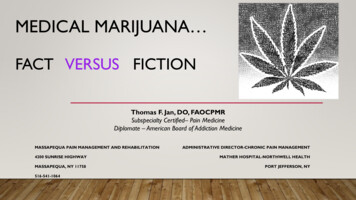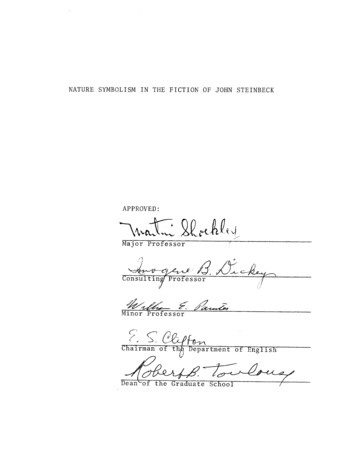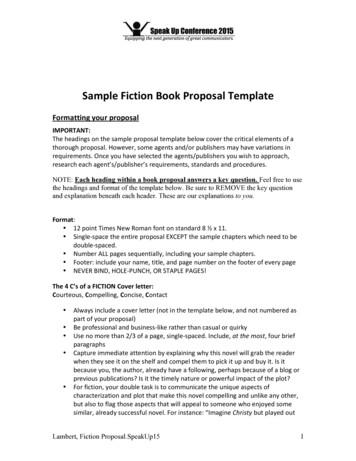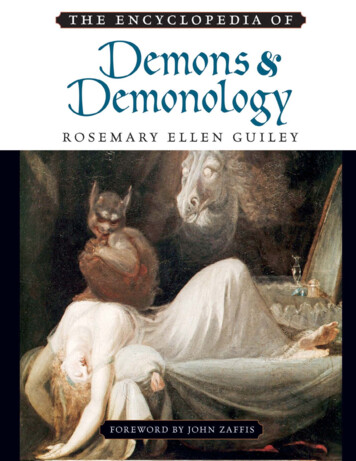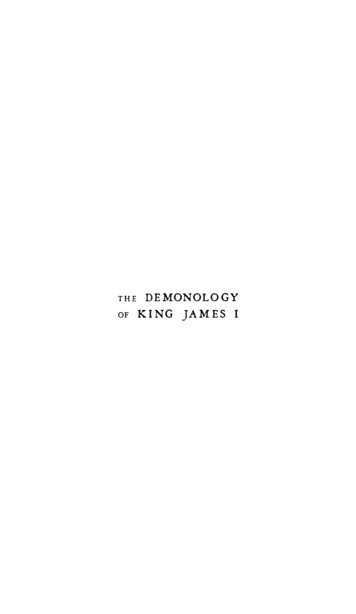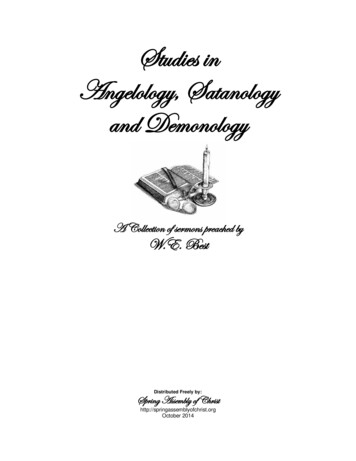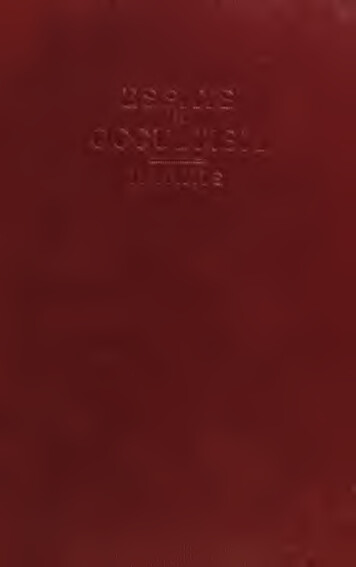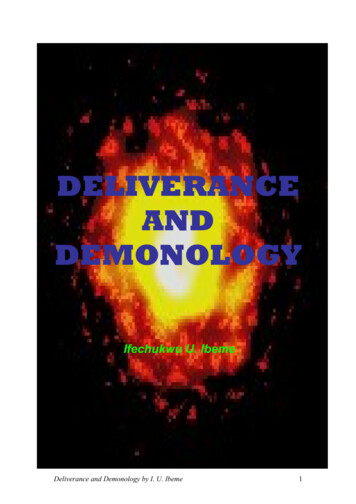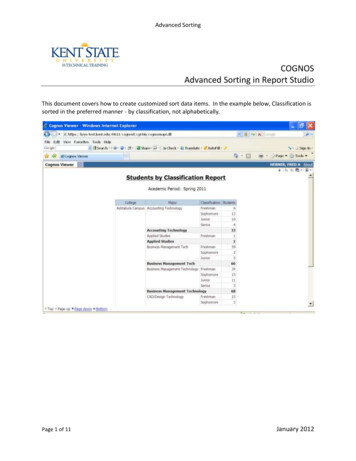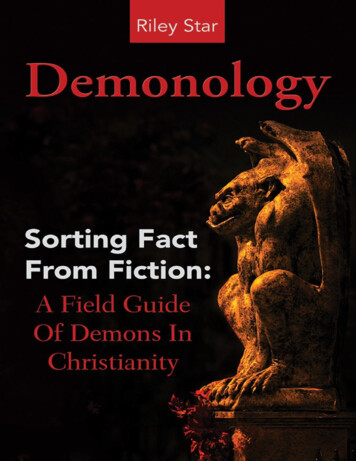
Transcription
DemonologySorting Fact From Fiction: A Field Guide OfDemons In ChristianityBy Riley Star
Copyrights and TrademarksAll rights reserved. No part of this book may be reproduced or transformed in any form orby any means, graphic, electronic, or mechanical, including photocopying, recording,taping, or by any information storage retrieval system, without the written permission of theauthor.This publication is Copyright 2015. All products, graphics, publications, software andservices mentioned and recommended in this publication are protected by trademarks. Insuch instance, all trademarks & copyright belong to the respective owners.Disclaimer and Legal NoticeThis product is not legal, medical, or accounting advice and should not be interpreted in thatmanner. You need to do your own due-diligence to determine if the content of this productis right for you. While every attempt has been made to verify the information shared in thispublication, neither the author, neither publisher, nor the affiliates assume anyresponsibility for errors, omissions or contrary interpretation of the subject matter herein.Any perceived slights to any specific person(s) or organization(s) are purely unintentional.We have no control over the nature, content and availability of the web sites listed in thisbook. The inclusion of any web site links does not necessarily imply a recommendation orendorse the views expressed within them. We take no responsibility for, and will not beliable for, the websites being temporarily unavailable or being removed from the internet.The accuracy and completeness of information provided herein and opinions stated hereinare not guaranteed or warranted to produce any particular results, and the advice andstrategies, contained herein may not be suitable for every individual. Neither the author northe publisher shall be liable for any loss incurred as a consequence of the use andapplication, directly or indirectly, of any information presented in this work. Thispublication is designed to provide information in regard to the subject matter covered.Neither the author nor the publisher assume any responsibility for any errors or omissions,nor do they represent or warrant that the ideas, information, actions, plans, suggestionscontained in this book is in all cases accurate. It is the reader’s responsibility to find advicebefore putting anything written in this book into practice. The information in this book isnot intended to serve as legal, medical, or accounting advice.
ForewordFor 11 years, I cared for an elderly aunt who suffered a debilitatingstroke in 2002. What began as the kind of short-term memory losstypical after such an event gradually became deep-seated and thenviolent dementia.A woman who had been regarded by all who knew her as a nurturing,loving presence became a foul-mouthed, angry harridan. There wereno filters left. Everything that came out of her mouth was filled withhatred and vitriol.She abandoned any attempts at personal hygiene, and even used herown bodily by-products as weapons. Had we been living in theMiddle Ages, I would likely have appealed to a priest to cast out whatwas surely a demon possessing her body.Since we were living in the United States at the close of the 20thcentury, I was shocked when my business partner told me that shehad been cautioned to break off her association with me. A familymember who practiced a fundamentalist branch of the Christianfaith told my partner that I could be a conduit by which Satan wouldenter her household.The woman reasoned that the devil had infected my aunt, and wouldjump from her through me to corrupt another family. Or at least Ithink that’s how the “infection” was supposed to occur. I was soshocked by what I was hearing, I didn’t ask for the specifics.Having witnessed my aunt’s mental decline to the ravages of
dementia, I can say, without question, that it is as if an alien being isin possession of your loved one’s mental faculties. There were timeswhen I could not believe what was coming out of her mouth.I wasted hours trying to reason with her and to appeal to the person Iwas sure must still be in there amidst all that confusion. I know nowthat I was engaged in a hopeless endeavor, but never at any point didI think I was waging battle with the Devil.In the months that followed my aunt’s death, as I struggled to cometo terms with many aspects of my long-term caregiving experience,my mind kept coming back to this suggestion that Satan had comeinto our home.It was then that I really became aware of a growing popularperception that Lucifer is an active agent in the world and thatmankind is locked in the middle of an epic struggle between ultimategood and ultimate evil.This book came out of my personal research into a topic that at first Ifound both amusing and annoying. I am hardly a candidate for aremake of the pea soup scene in The Exorcist, but with no medicalexplanation of dementia, I came to see how possession would haveonce seemed a real possibility.The perceived role of demons in the spiritual thought of Westernsociety is a fascinating topic, and one that can provide a lifetime ofstudy. I found the major stumbling block to be separating fact fromfiction. The popularity of paranormal books and films, as well as awhole host of “scary” movies and TV shows has created a huge bodyof fictional demonic lore that, while entertaining, has little basis intheology.
There are plenty of people, my business partner included, who sayit’s all fiction, but I am a great lover of myth, a word I hasten todefine in the text as an instructive story. You must get over the ideathat a myth is something false to come at this material from theinterpretational angle I am suggesting.Deciding whether actual demons are real or not is, as they say,“above my pay grade.” I do think, however, that evil exists in thisworld. It takes only a few seconds of scanning the headlines to cometo this conclusion. Mankind has been attempting to explain evil andto deal with its presence for millennia.This books explores that same theme, and is an effort to get back tomore concrete perceptions of demons and demonology as expressedin Western Christianity. Whether real or symbolic, demons representthose aspects of the human condition and moral struggles thatplague us all.
Table of Contents
Table of ContentsPart 1 - A Theological Look at DemonologyPopular Culture DemonologyThe Evolving Role of SatanThe Story of SethAngels in the HebrewThe Personification of SatanWhat are Demons According to the BibleWhat about Demonic Possession?What About the Current Paranormal Preoccupation?Part 2 - Considering Demonic PossessionPossession in Colonial New EnglandThe Demon of Murder?The Real Story of the ExorcistThe Most Famous American ExorcismA Classic Case from 1906Possession or Mental Illness?The Children of Latoya AmmonWhat Do These Stories Reveal?Protection Against Demonic ForcesThe Circle of Light PrayerPrayer to the Archangel MichaelThe Twenty-Third PsalmPrayer of JabezPart 3 – Demons A - ZAbaddon/ApollyonAdramelechAgares
hBifronsBotisBuerBuneCaimCimejesCorson
thanLucifuge RofocaleMalphasMammonMaraxMephistophelesMerihem
VineXaphanZagan
ZeparPart 4 – Concluding RemarksWorks ConsultedIndex
Part 1 - A Theological Look at DemonologyWhat exactly is demonology? Like any word that ends in “ology,” it’stempting to simply say, “Demonology is the study of demons,” andbe done with it. Unfortunately, understanding demonology as anaspect of theology is not that simple.It is perhaps more accurate to say that demonology is the study ofsupernatural beings that are not gods. This can include spirits thatmight also be considered benevolent. The discipline varies widely bycultural and spiritual belief.If, for instance, you believe in demons that are the minions of Satan,but have a strong attraction to a nature religion like Wicca, you mightalso believe in fairies, elves, sprites or other “spirits” that areconsidered “mischievous,” but not necessarily “evil” per se. Thisbook will look at demonology in a Western Christian context. It isnot, however, a religious book in and of itself.In the 21st century, more people have a passing conversance withdemonology than you might expect, but much of that “knowledge” is
derived from popular culture. While entertaining, and oftenfrightening, this type of demonology generally has little to do withthe theological study of demons.Popular Culture DemonologyTelevision programs like Buffy the Vampire Slayer, Supernatural, SleepyHollow, Being Human, Witches of East End, and Constantine have givenan entire generation a paranormal and demonic vocabulary.Reality programs such as Ghosthunters often feature “demonhunters” like John Zaffis and Ed and Lorraine Warren who claim tooverlay “fact” on fiction. Zaffis scored his own show, HauntedCollector, and the Warrens first came to fame due to theirinvolvement in the Amityville Horror case. But how does thisblending of entertainment and theology serve the popular perceptionof demonology? Often, poorly.One of the most beloved characters in the Buffy series was a greenskinned “Deathwok Clan” demon with red horns named Lorne. Hehad more in common with a Frank Sinatra-esque lounge singer thana bloodthirsty creature from another realm — and zero credibility interms of established demon lore. Lorne is a charming fictionalcreation, but he has no basis in fact. On the other hand, Moloch, thedemonic bad guy that plagued “witnesses” Ichabod Crane andAbigail Mills in the first season of the Fox series Sleepy Hollow doeshave proper demonic bona fides.Moloch is spoken of in the Bible, as well as in Milton’s Paradise Lost.Long associated with child sacrifice, the series writers made Moloch’schief agent the disaffected and scarred son of Crane and his witchwife, Katrina. While granted a “mashup” of Washington Irving’s
original Legend of Sleepy Hollow and esoteric religious literature, theresult is much more commendable than most such attempts.In 2014, NBC made a demonic entry in their Friday night line-up withConstantine, an adaptation centering on a character from the DCComic Hellblazer. In the series, rogue exorcist and demon hunterJohn Constantine protects the innocent and battles the forces ofdarkness in uneasy alliance with an angel named Manny. KeanuReeves played the same demon hunter in a 2005 film adaptation alsocalled Constantine.In a review of that work published in the Journal of Religion and Film,Jeffry Mallinson, dean of the School of Theology at ColoradoChristian University wrote:Audience members with any theological or biblical backgroundwill have difficulty willfully suspending disbelief. Much of theplot depends on a caricature of Roman Catholic theology whereone is damned on a technicality or redeemed through aloophole. All of this occurs without the satire of Dogma (1999)*.Particularly distracting are moments when John's Apocalypse iscalled "Revelations," and when an esoteric prophecy is found ina lost chapter of 1 Corinthians. The imagined text would havebeen more plausible as a Gnostic manuscript or secret copy of"Revelations." This may seem hypercritical; yet such distractionshinder the creation of a plausible fantasy world.* Dogma, with Ben Affleck and Matt Damon, is summarized onIMDB.com in this way: “An abortion clinic worker with a specialheritage is called upon to save the existence of humanity frombeing negated by two renegade angels trying to exploit a loophole and reenter Heaven.”
While it might, indeed, seem hypercritical to take exception with theBook of Revelation being referred to incorrectly in the plural, thegreater point is the ease with which scripture and esoteric texts canbe used as plot devices with no fear of a discerning general publicquibbling. The average “man on the street” would be hard pressed topronounce much less correctly identify the origin of a Gnosticmanuscript.Note:Gnosticism was a 2nd century heretical movement in Christianity thattaught a belief in the demiurge, a lesser divine being who ruled theearth, while Christ was seen as the emissary of a more remote andsupreme being. In this school of thought, salvation or redemptiondepended on the attainment of esoteric knowledge or “gnosis.”)These same “men on the street,” who would draw a blank onGnosticism could undoubtedly identify “666” as the mark of the antiChrist, offer up at least one paranormal story about a haunting, andlikely assert the presence of Satanic worshippers among us. Nevermind the fact that Satanists in the tradition of Anton LaVey, do notworship the Christian devil nor are they interested in being the evilcounterparts of Christian churches.LaVey’s followers are, however, atheistic and materialistic. For them,Satan and demons are psychological symbols and representations ofhumankind’s vital nature. Unlike teenagers spray-painting invertedcrosses and burning black candles, Satanists rarely perform rituals.They do approach life from a skeptical perception and embraceunbridled devotion to sensual enjoyments of all kinds from fine foodto sexual pleasure.You can feel free to mix anything else you like into this “common
knowledge” conception of Satan, demons, and evil. Throw in a littleblack metal music and Harry Potter for good measure. Few of theassociations really hold together in a factual interpretation, but theydo fit neatly into a fundamentalist religious filter that posits a cosmicbattle between the ultimate good, God, and the ultimate evi
This books explores that same theme, and is an effort to get back to more concrete perceptions of demons and demonology as expressed in Western Christianity. Whether real or symbolic, demons represent those aspects of the human condition and moral struggles that plague us all. Table of Contents. Table of Contents Part 1 - A Theological Look at Demonology Popular Culture Demonology The
